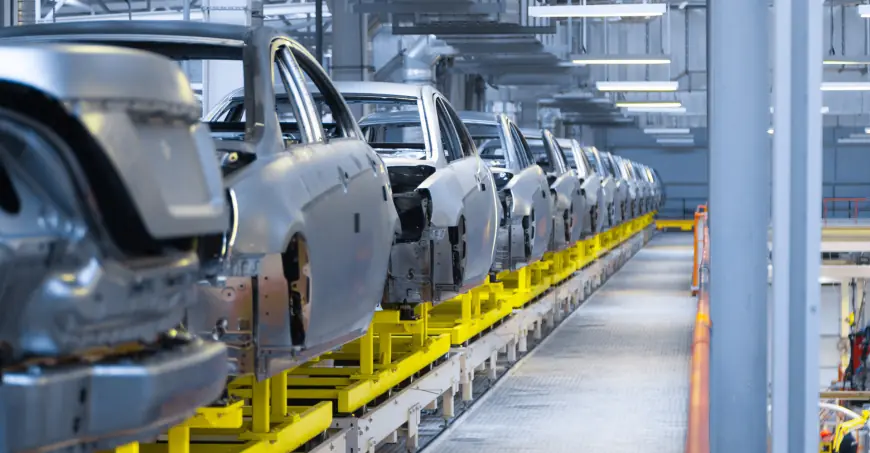Digital Trends in GCC Automotive Logistics Market 2030
Saudi Arabia’s Vision 2030 drives the country’s goal to produce 300,000 vehicles annually by 2030, with strong support for domestic electric vehicle makers like Ceer Motors.

Executive Summary
The GCC Automotive Logistics Market was valued at USD 6.4 billion in 2024 and is projected to reach USD 8.2 billion by 2030, at a CAGR of 4.9% over the forecast period. This dynamic growth is fueled by an expanding automotive ecosystem across the Gulf Cooperation Council (GCC) countries—home to major vehicle production hubs, rising consumer demand, booming e-commerce, and ambitious infrastructure agendas under national visions such as Saudi Vision 2030 and UAE’s post‑oil diversification strategies.
To meet mounting logistics needs, stakeholders are investing strategically in optimized supply chain systems, employee training, digital platforms, and sustainable practices. However, they also contend with challenges including fuel-price volatility, regulatory shifts, rising competition, and the imperative to adapt quickly.
Industry Key Highlights
- Market Size & Forecast (2024–2030F): From USD 6.4 billion today to an estimated USD 8.2 billion by 2030, growing at a stable CAGR of 4.9%.
- Service Segment Leadership: Transportation services lead the value chain, driven by high demand for finished-vehicle movement and parts distribution.
- Key Geographies: Saudi Arabia dominates due to a growing domestic automotive base and strong infrastructure investments; UAE, Qatar, Kuwait, Oman, and Bahrain follow closely.
- Segments Covered: Finished vehicles, auto components, aftermarket parts—alongside services like warehousing, inventory management, and multi-modal distribution.
- Evolving Models: Integration of digital tools, AI-based route planning, warehouse automation, and real-time tracking systems are accelerating operational efficiency.
Download Free Sample Report: https://www.techsciresearch.com/sample-report.aspx?cid=27893
Market Drivers
1. Rising Automotive Production & Distribution
With expanding OEM facilities and assembly plants across the Gulf, demand for logistics to ferry finished vehicles and spare parts—both domestically and internationally—is surging. This has thrust automotive logistics into sharper focus.
2. Strategic Infrastructure Initiatives
Government-led mega-projects (e.g., Saudi NEOM, UAE's Abu Dhabi-Al Ain Milan road network) are enhancing connectivity, reducing transit times, and supporting growth in logistical capacity. Nation-wide vision plans—such as Saudi Vision 2030 and the UAE’s economic diversification—are also powering logistics infrastructure.
3. Digital Transformation & Supply Chain Optimization
Modern transportation management systems (TMS), warehouse management systems (WMS), AI-based route optimization, IoT-enabled tracking, and robotics in warehousing are enabling GCC logistics players to achieve significant cost and time efficiencies.
4. E‑Commerce Acceleration
Surging online sales—including auto parts, accessories, and specialized automotive goods—have created new last-mile and reverse logistics demands. Automotive logistics providers are broadening their offerings to include parcel delivery for auto e‑commerce.
5. Regulatory & Environmental Pressures
Governments across the region are tightening regulations aimed at lowering carbon emissions, increasing vehicle safety, and improving transport sustainability. Higher standards around load tracking, vehicle handling, and warehouse operations are also in focus, pushing providers to elevate service quality.
Emerging Trends
• Green Logistics & Electrification
Investments in electric heavy-duty vehicles for transport fleets, adoption of cleaner fuels, and carbon-offset initiatives are gaining traction—aligning with broader national sustainability agendas.
• Integrated Logistics Platforms
Players are shifting toward end-to-end platform solutions, bundling transportation, warehousing, inventory, and value-added services (e.g., kitting, packaging, aftermarket delivery) under single digital dashboards.
• AI & Data Analytics Adoption
Predictive analytics forecasting demand peaks, optimizing fleet utilization, and proactive route planning are increasingly enabling cost savings and higher service reliability.
• Cold-Chain for EV Components
Particularly pertinent in light of the EV push: sensitive battery packs, control modules, and lithium-ion cells require temperature-controlled handling and specialized container systems—a fast-emerging niche.
• Just‑in‑Time (JIT) Auto Component Delivery
OEMs are embracing lean manufacturing. Logistics providers now collaborate closely with assembly plants to deliver components in precisely scheduled windows, minimizing inventory and supporting lean operations.
Market Segmentation Overview
By Service
- Transportation Services: Dominating the market, especially for finished-vehicle haulage and inter-country movement by road and RO‑RO shipping.
- Warehousing & Inventory Management: Warehouses across free zones and industrial hubs serving OEMs and parts suppliers.
- Distribution & Multi‑modal Services: Interaction between air, sea, and road transportation channels that ensure speed and flexibility.
- Other Services: Value-added operations like kitting, reverse logistics, cross-docking, and packaging.
By Type
- Finished Vehicle Logistics
- Auto Component Logistics
- Aftermarket & Other Automotive Goods
By Country
- Saudi Arabia: Largest contributor, owing to a domestic automotive market and heavy investment in transportation projects.
- UAE, Qatar, Kuwait, Bahrain, Oman: Each plays a vital supporting role, with Dubai and Abu Dhabi acting as regional logistics hubs.
Competitive Analysis
Key Market Players:
- CEVA Logistics AG
- Deutsche Bahn AG
- DHL International GmbH
- DSV Panalpina A/S
- GEODIS S.A.
- Kuehne + Nagel International AG
- Nippon Express Co. Ltd.
- Ryder System Inc.
- United Parcel Service Inc.
- Yusen Logistics Co., Ltd.
Competitive Landscape Overview:
- Global majors dominate by leveraging vast networks, scale operations, and technological investments.
- Regional/logistics specialists offer tailored services—e.g. import clearance for CKD kits, epaper-based traceability compliance, Saudi‑specific warehousing.
- Niche players (e.g., EV-focused or parts intermodal providers) are differentiating via specialized infrastructure or partnerships with auto OEMs.
- Key differentiators: integrated digital capability, sustainability credentials, regional mastery, speed-to-market, and data transparency.
Emerging Trends (Expanded)
• Advanced Eco-Friendly Fleet Adoption
Major logistics players are trialing electric heavy-duty vehicles or transitioning to cleaner fuel options (CNG, hydrogen) for intra-regional transit—a trend aligned with GCC sustainability plans.
• Logistics-as-a-Service (LaaS)
Emergence of platforms enabling OEMs or importers to book full-service logistics—from transportation and storage to kit fulfillment and delivery—via cloud-based portals.
• Blockchain for Compliance & Traceability
Digital ledgers are being used to ensure authenticity of auto parts, enable smoother customs clearance, and improve end-to-end transaction transparency.
• Integration with EV Manufacturing
As GCC automakers pivot toward assembly of EVs, logistics companies are positioning to handle high-value, temperature-controlled batteries and modules, including return logistics for recycling programs.
• Data-Driven Fleet Management
Telematics-enabled fleet monitoring and predictive maintenance not only reduce downtime but help to manage insurance premiums and operational efficiency.
Drivers (Expanded)
- Infrastructure-led Growth: New road corridors, expanded ports, and industrial clusters drive demand for timely logistics.
- OEM Alignment: Logistics providers offer tailored low-cost, high-reliability delivery schedules to global OEMs setting up in the region.
- E-Commerce & Aftermarket Expansion: Growing parts & accessories sales online requiring consumer and dealer delivery networks.
- Government Initiatives: Regulatory support such as freight corridors, free zone logistics enhancements, and foreign investment incentives.
- Tech-Enabled Optimization: Investments in modern digital tools that streamline route planning, inventory forecasting, warehouse throughput.
Future Outlook
By 2030, the GCC Automotive Logistics Market is anticipated to evolve in the following ways:
- Smart & Sustainable Fleets: Solar-powered depots, electric trucks, and emission reporting will become standard across major players.
- Logistics Digital Platforms: Seamless integration—from order placement, ETA tracking, automated compliance to GPS tracing—for both OEMs and aftermarket clients.
- Cold‑chain Readiness for EV Components: Battery haulage and temperature-sensitive flows becoming significant value-added services.
- Pan‑GCC Network Synchronization: Greater connectivity between member states, enabling OEMs to use GCC logistics as a multi-country hub for regional distribution.
- Localized Specialization by Service Type: Some providers focusing solely on finished vehicles, others on aftermarket parts or component routing.
10 Benefits of the Research Report
Below are ten clear, value‑oriented benefits that a buyer would gain by using the full TechSci report:
- Comprehensive Market Sizing & Forecasts: 2024 base estimate and projections to 2030 by country, service type, and logistics segments.
- Competitive Benchmarking: Side‑by‑side comparison of leading logistics firms operating in the GCC—CEVA, DHL, DSV, UPS, Yusen, etc.
- Detailed Segmentation: Insight into transportation, warehousing, inventory & aftermarket components, plus vehicle logistics flows.
- Strategic Driver & Challenge Analysis: Identification of infrastructure, policy, demand, and digital drivers contrasted against risk areas like fuel volatility.
- Emerging Trends & Innovation Mapping: Coverage of AI-enabled routing, blockchain use cases, green fleets, JIT & EV logistics trends.
- Country-level Insights: Deeper examination of key markets including Saudi Arabia, UAE, Qatar, Kuwait, Bahrain, and Oman—with growth hotspots identified.
- Opportunity Identification: Segments ripe for expansion, such as e‑commerce delivery, aftermarket parts, EV component logistics and cold‑chain systems.
- Regulatory & Sustainability Considerations: Guidance on compliance rules, carbon emissions strategy alignment, and logistics standards.
- Supply Chain Best Practices: Use cases and frameworks for lean, agile, digitally enabled automotive logistics management.
- Investment & Partnership Guidance: Clear view on routes to local OEM tie-ups, value-added services, and innovation partnerships to stay competitive.
Competitive Analysis – Strategic Insight
Strengths of Leading Players:
- Global Reach & Infrastructure: Companies like DHL, CEVA, Kuehne + Nagel bring vast cross-border experience and multi-modal networks.
- Digital Leadership: Early adopters of TMS/WMS, blockchain traceability, telematics fleet tracking, and logistics AI.
- Value‑added Services: End-to-end differentiation through cargo tracking, predictive lead times, JIT deliveries, and EV component catering.
Challenges for Entrants:
- Capital-Intensive Set-Up: High technological investment required for automation, green fleet adoption, and cold storage facilities.
- Pricing Pressures: Fierce competition from regional startups and local integrators on cost-per-mile routes.
- Regulatory Complexity: Adapting to evolving tariff rules, customs protocols, and national carbon targets remains resource-intensive.
- Talent Gaps: Technical know-how needed in advanced logistics, digital systems, and cold-chain management.
Future Outlook – 2030 Horizon
As we approach 2030, the GCC automotive logistics market is expected to transition into a fully digitized, sustainability‑oriented, and integrated ecosystem:
- EV logistics specialization, handling batteries, lightweight component routing, and battery recycling flows.
- Inter-GCC freight corridors connecting Saudi ports, Dubai free zones, and Kuwaiti industrial hubs as a logistics loop.
- Logistics embedded in OEM assembly lines, with just-in-time parts scheduling and direct inventory replenishment strategies.
- Automated micro-fulfillment centers for parts delivery to dealers and after-sales centers across dense urban zones.
- Digital compliance & carbon reporting becoming standard, with logistics providers offering ESG‑verified chains.
By 2030, we anticipate the GCC Automotive Logistics Market to not merely serve transportation needs, but to become a core pillar of the region’s industrial modernization—linking automotive manufacturing, smart infrastructure, trade corridors, and digital service delivery.
Conclusion
The GCC Automotive Logistics Market is on course for strong and steady growth—driven by expanding automotive demand, infrastructure investment, digital transformation, and a push toward smarter, greener logistics. Key growth verticals include finished vehicle transportation, parts logistics, and e‑commerce after-sales flows, with Saudi Arabia leading regional development.
Success in this evolving landscape will depend on technological capability, eco‑compliance readiness, infrastructure alignment, and the ability to provide differentiated, value‑added logistics solutions. For stakeholders, the TechSci Research full report provides essential, actionable intelligence to navigate this dynamic market effectively and capitalize on emerging opportunities through 2030 and beyond.
Contact Us-
Mr. Ken Mathews
708 Third Avenue,
Manhattan, NY,
New York – 10017
Tel: +1-646-360-1656
Email: [email protected]
Website: www.techsciresearch.com
What's Your Reaction?
 Like
0
Like
0
 Dislike
0
Dislike
0
 Love
0
Love
0
 Funny
0
Funny
0
 Angry
0
Angry
0
 Sad
0
Sad
0
 Wow
0
Wow
0



















































